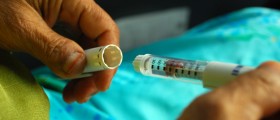
Drug allergy rash is a skin reaction that develops due to the intake of certain medications a person is allergic to. Only if an individual has developed sensitivity to the specific drug and has taken the same drug once again this type of rash will develop. Drug allergy rash is actually one of the possible side effects of many medications. This rash typically features with mild redness and peeling. It usually develops in a form of hives. Apart from skin reaction a person allergic to particular drug may also develop additional symptoms and signs. One of the most serious side effects of allergy to medications is anaphylactic shock which, if not treated on time, may cause lethal outcome.
More on Drug Allergy Rash
Rash associated with allergic reaction to some medications develops soon after the particular drug has been taken. The skin reaction may develop after the intake of different forms of medications (pills, injections, topical creams etc.). In order for such reaction to occur the person must have already been exposed to certain substances found in the drug. The first exposure is accompanied by sensitization. When the drug is taken for the second time the person who is now sensitive to certain components of the drug develops a characteristic allergic reaction, many times in a form of rash.
There are also cases when an individual develops rash and there is no allergic reaction. This usually occurs in case of the intake of corticosteroids or lithium. These drugs are associated with a rash that resembles acne. Furthermore, some drugs may induce Steven-Johnson syndrome, toxic epidermal necrolysis and erythema nodosum, all of which feature with characteristic skin changes.
It is also essential to mention the ability of certain drugs to induce photosensitivity, to make one more susceptible to sun rays during treatment. Namely, if such medications are taken and the person is exposed to sun rays he/she is most likely to develop characteristic skin changes. The explanation is simple. Some components of the drug come into the skin cells and react with sun rays. Certain antipsychotics, tetracycline and several more antibiotics such as sulfa antibiotics and chlororthiazide are some of the drugs connected with photosensitivity.
Clinical Characteristics of Drug Allergy Rash
Drug allergy rash features with mild redness and there are small bumps all over the affected area. There may also be peeling of the entire skin. The allergic reaction develops within several minutes or it can occur hours or even days after the drug has been taken.
It is essential to mention that there are usually additional symptoms and signs such as runny nose, wheezing and in severe cases a person may develop anaphylaxis.
Treatment for Drug Allergy Rash
It is essential to set the correct diagnosis and determine whether a person is allergic to the drug he/she is taking or not. The very skin reaction and timing when the drug has been taken may help the doctor to set the diagnosis. Once the allergy is confirmed the medication is immediately discontinued and, if possible, replaced with a suitable substitute a person is not allergic to.
In many cases once the drug is discontinued there is no need for further treatment and the rash withdraws spontaneously. On the other hand, severe allergic reactions, particularly anaphylaxis, require prompt treatment with specific drugs such as injections of epinephrine, diohenhydramine and corticosteroids.

















Your thoughts on this
Loading...